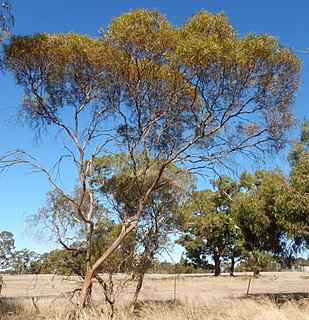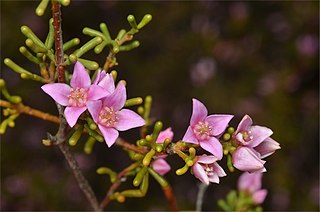
Banksia leptophylla is a species of shrub that is endemic to the south-west of Western Australia. It has narrow linear leaves, heads of yellow or pale brown flowers with a yellow or purple style and later, up to eight egg-shaped follicles in each head.

Banksia scabrella, commonly known as the Burma Road banksia, is a species of woody shrub in the genus Banksia. It is classified in the series Abietinae, a group of several species of shrubs with small round or oval inflorescences. It occurs in a number of isolated populations south of Geraldton, Western Australia, with the largest population being south and east of Mount Adams. Found on sandy soils in heathland or shrubland, it grows to 2 m (7 ft) high and 3 m (10 ft) across with fine needle-like leaves. Appearing in spring and summer, the inflorescences are round to oval in shape and tan to cream with purple styles. Banksia scabrella is killed by fire and regenerates by seed.

Banksia telmatiaea, commonly known as swamp fox banksia or rarely marsh banksia, is a shrub that grows in marshes and swamps along the lower west coast of Australia. It grows as an upright bush up to 2 metres tall, with narrow leaves and a pale brown flower spike, which can produce profuse quantities of nectar. First collected in the 1840s, it was not published as a separate species until 1981; as with several other similar species it was previously included in B. sphaerocarpa.

Astartea is a genus of flowering plants in the myrtle family, Myrtaceae. The genus is endemic to southwestern Western Australia. The genus name was inspired by Astarte, the Greek name for the goddess Ishtar.
This is a timeline of developments in knowledge and understanding of the Australian plant genus Banksia:
Banksia leptophylla var. melletica is a variety of Banksia leptophylla. It is native to the Southwest Botanical Province of Western Australia.
Banksia leptophylla var. leptophylla is a variety of Banksia leptophylla. It is native to the Southwest Botanical Province of Western Australia. As an autonym, it is defined as containing the type specimen of the species.

Astartea fascicularis is a species of flowering plant in the myrtle family, Myrtaceae. It is endemic to southwestern Western Australia, where it is widespread in the Recherche Archipelago and present on the mainland in Cape Le Grand National Park. It is commonly known as Recherche astartea. or false baeckea.

Persoonia mollis, commonly known as soft geebung, is a plant in the family Proteaceae and is endemic to New South Wales. It is an erect to prostrate shrub with linear to oblong or spatula-shaped leaves, yellow flowers in groups of up to thirty on a rachis up to 150 mm (5.9 in) long and relatively small fruit.

Eucalyptus leptophylla, commonly known as the March mallee, slender-leaved red mallee or narrow-leaved red mallee, is a species of mallee that is endemic to inland Australia. It has smooth greyish bark, linear to narrow lance-shaped, oblong or curved adult leaves, flower buds in groups of between seven and thirteen, creamy white flowers and cup-shaped, barrel-shaped or hemispherical fruit.
Grevillea pauciflora, commonly known as the few-flowered grevillea, is a shrub of the genus Grevillea native to an area along the south coast in the Great Southern and Goldfields-Esperance regions of Western Australia.
Astartea affinis, commonly known as west-coast astartea, is a shrub endemic to Western Australia.
Astartea arbuscula, commonly known as minute astartea, is a shrub endemic to Western Australia.
Astartea aspera, commonly known as rough-stemmed astartea, is a shrub endemic to Western Australia.
Astartea astarteoides is a shrub endemic to Western Australia.
Astartea corniculata is a shrub endemic to Western Australia.

Astartea glomerulosa, commonly known as early astartea, is a shrub endemic to Western Australia.
Astartea muricata, commonly known as inland astartea, is a shrub endemic to Western Australia.

Astartea scoparia, commonly known as common astartea, is a shrub endemic to Western Australia.

Boronia inornata, commonly known as desert boronia, is a plant in the citrus family, Rutaceae and is endemic to southern Australia. It is an erect shrub with three-part leaves and pink, red or white, four-petalled flowers.








